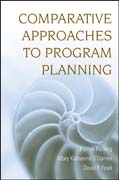
Written by leaders in the social work education community, this innovative book provides practical and creative ways to effectively conduct program planning within human service organizations, comparing prescriptive and emergent approaches to planning. Covering both the philosophical and intellectual understanding of rational and interpretive program planning, the authors present two very different approaches to the planning process. INDICE: Chapter 1. Differences Between Lines And Circles. Lines and Circles as Planning Metaphors. A Brief History of Lines Services and Interventions. Programs and Projects. Services and Interventions. Programs in Organizational Context. Program Planning. Mandates & Initiatives. Planning Different Types ofPrograms. Summary. Discussion Questions. Chapter 3. Rational Planning And Prescriptive Approaches. Case: The Mayor and the Street Educators. Introduction. History of Rational Planning and Prescriptive Approaches. Dimensions of Rational Planning and Prescriptive Approaches. The Logic Model. Assessing Needs. Defining and Analyzing Problems. Selecting Intervention Strategies. Writing Goalsand Objectives. Program Design and Decision-Making. Accountability in a Prescriptive Approach. Accountability Challenges. Information Systems. Budgeting. Rational Planning. Mind Sets. Skills. Strengths and Challenges of Rational Planning. Summary. Discussion Questions. Chapter 4. Interpretive Planning And Emergent Approaches. Case: The Invisible People and the Area Agency on Aging. Introduction. History of Interpretive Planning and Emergent Approaches. Dimensionsof Interpretive Planning and Emergent Approaches. The Logic of Emergence. Engagement. Discovery. Sensemaking. Unfolding. Accountability in an Emergent Approach. Accountability Challenge. Accountability Options. Interpretive Planning.Mind Sets. Skills. Strengths and Challenges of Interpretive Planning. Summary. Discussion Questions. Chapter 5. Knowing When To Use What Planning Approach.An Example: AIDS Orphans and the Pig Intervention. Similarities in Planning Approach Challenges. Gaining Entry. Becoming Oriented. Engaging in Critical Thinking. Making Ethical Decisions. Comparing Program Planning Approaches. Comparing Dimensions. Examining Accountability. Thinking about Mindsets and Skills. Decision Issues for Approach Selection. Summary. Discussion Questions. Appendix. Chapter 6. Program Planning In Diverse Cultural Contexts. Culture and Context. Defining Culture. Elements in Culture Development. Cultural Competence. Skills of the Culturally Competent. Challenges to Culturally Competent Human Service Programming. Understanding Empiricism. Recognizing Realism and Rationalism. Responding to Accountability Demands. Cultural Competence and Program Planning. Planning with Sensitivity to Difference. Differences within the Mainstream.& Within-Group Differences. Planning with Sensitivity to Inclusion. Planningwith Sensitivity to Context. Planning Across Multiple Organizational Settings. Issues when Practicing Internationally. Summary. Conclusion. Exercises. Glossary. References. Index.
- ISBN: 978-0-470-12641-7
- Editorial: John Wiley & Sons
- Encuadernacion: Rústica
- Páginas: 320
- Fecha Publicación: 16/04/2008
- Nº Volúmenes: 1
- Idioma: Inglés
